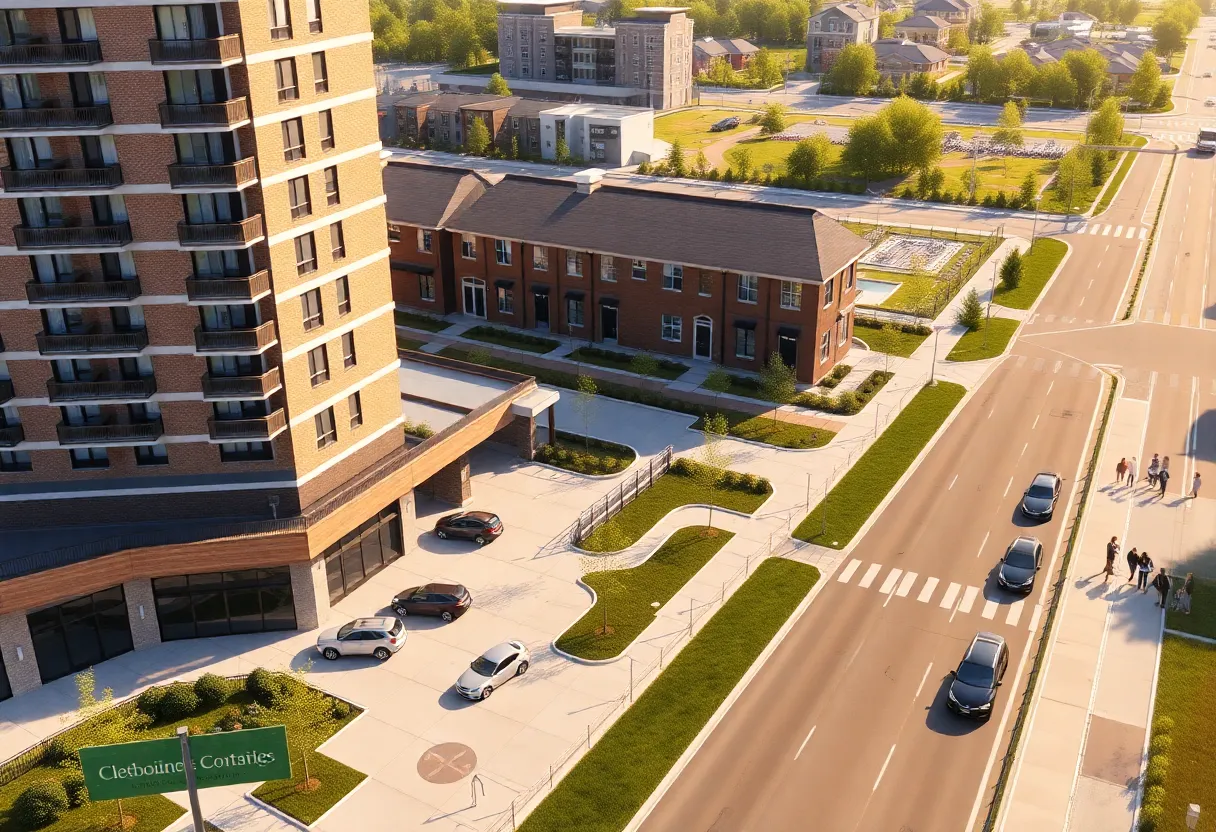Dublin, Ireland, September 8, 2025
News Summary
A major market study forecasts significant expansion in the global construction market, driven by housing, commercial development and infrastructure, with sustainability and advanced technologies accelerating change. Africa’s data‑centre construction is identified as a faster‑growing niche due to cloud demand and AI workloads. The specialist insurance sector is consolidating after an acquisition of a Dublin and Galway underwriting business focused on construction risks. A partial collapse of a derelict Dublin terrace with large unpaid levies highlights safety, fiscal and planning challenges posed by long‑term vacancy. Together the trends point to growth, innovation and evolving risk management needs.
Global Construction Market at a Glance: Size, Growth and Long‑Term Trends
Global construction activity is forecast to rise from about USD 13.4 trillion in 2025 to roughly USD 20.6 trillion by 2033, driven by a steady 5.51% annual growth over the period. This broad market covers homes, offices, factories and the big, road, rail and airport projects that connect cities. In plain terms, the sector acts as a major engine of economic development, offering jobs and pushing advances in materials, technology and project planning methods.
The market’s footprint is not limited to new builds. It also includes maintenance, upgrades, and long‑term infrastructure programs. As cities grow and industries modernize, construction teams are increasingly focused on delivering projects that blend durability with efficiency. Across the sector, the push toward better design and smarter construction methods is reshaping how work gets done on sites of all sizes.
Key themes shaping the forecast include a shift toward sustainability and the adoption of digital tools and new construction technologies. Green building rules, energy‑efficient designs, and the use of renewable materials are becoming standard on many schemes. At the same time, digital aids such as Building Information Modeling (BIM), 3D printing, and automated equipment are helping teams plan with more precision, cut waste, and coordinate more effectively with all project partners. These innovations are often linked to cost savings and higher quality outcomes in the longer run.
Where the Growth Is Happening: Segments and Technologies
The market spans a wide range of activities, from residential construction and commercial structures to large‑scale infrastructure projects like highways, bridges and airports. Market data highlight a diversified competitive landscape, with global firms, regional builders and specialist service providers all playing roles. Companies are increasing research and development to roll out new building methods, smart building systems and low‑carbon solutions.
Among the technology trends, BIM is helping teams plan more accurately, 3D printing is enabling quicker, more flexible production of components, and automated construction equipment is enhancing site productivity. These technologies are linked with better collaboration among stakeholders, reduced waste and potential savings that help projects stay on time and on budget.
African Data Center Market Shows Strong Acceleration
In a region‑focused view, the data center construction market in Africa is growing rapidly. The market was worth about USD 1.26 billion in 2024 and is projected to reach roughly USD 3.06 billion by 2030, reflecting a CAGR of 15.94% from 2024 to 2030. This surge is driven by rising cloud investments, stronger demand for computing power, and a broader shift toward renewable energy solutions in data center operations.
Analysts point to key drivers such as the spread of cloud services and the role of artificial intelligence in data center design and operation. The regional focus also highlights infrastructure requirements—electrical and cooling systems, mechanical infrastructure and general construction disciplines—that shape how data center campuses are built and upgraded. The Africa outlook underscores the importance of ongoing investment in support infrastructure to meet growing digital needs.
Acquisition Highlights: Ryan Specialty’s Expansion Into Ireland
A recent market development involves a major insurer and broker group acquiring a Dublin‑based underwriter that focuses on commercial construction insurance. The deal places the acquired company under a broader underwriting management framework, with management and technical leadership emphasizing cultural fit and a shared commitment to service levels in the Irish market. The new arrangement is expected to broaden product offerings and draw on the parent group’s platform and resources to support growth in Ireland’s construction insurance space.
The acquired business has built its niche around risk‑based products for the construction sector, including policies that address latent defects and owner‑controlled programs. Since its founding in the mid‑2010s, the firm has relied on a proprietary approach to risk modelling to help manage risk concentration and secure strong capital backing. The integration into the wider underwriting group is viewed as a natural fit that could extend services and support to brokers working with construction clients since 2019. Executives noted their aim to preserve service standards while expanding the range of capabilities available in the Irish market.
Local Challenge: Unpaid Derelict Site Levies in Dublin
In Dublin, a notable local issue involves a terrace of five Victorian cottages at a prominent canal frontage that partially collapsed after an early morning incident. The site has been on a derelict list since last year, and the managing federation for the construction industry has reportedly not paid more than a modest levy tied to the market value of the properties. The levy wheels into action as a charging mechanism designed to fund repair or redevelopment work and to deter long‑term dereliction. The unpaid balance is in the vicinity of six figures in euros, and the levy accrues interest over time.
The collapsed structure caused disruption to nearby pedestrian and cycling routes and drew attention to the broader issue of how derelict sites are managed, funded, and brought back into use. Local officials say the federation remains responsible for the site and for resolving the public concerns associated with the collapse, including plans to move forward with future redevelopment on adjacent properties. Community figures have called for stronger incentives and higher levies to encourage timely rehabilitation and reuse of vacant sites in housing‑hungry areas.
What These Points Mean for the Construction Sector
Taken together, these data points illustrate a sector that is growing in size and complexity. The global market remains large and expansive, with significant growth expected in specialized areas such as data centers in rapidly developing regions. At the same time, sector‑level governance and funding are key to maintaining safety, urban renewal and housing supply, as shown by the Dublin derelict site case. Technology adoption and sustainability requirements are reshaping how projects are planned, funded and delivered, while strategic moves by insurers and underwriters help support a more robust risk management framework for construction projects around the world.
Notes on the Source Material
The figures and trends summarized here reflect multiple market releases and regional outlooks. They describe size, growth rates and project timelines for the construction market globally, with dedicated notes on Africa’s data center market and on notable corporate movements in the construction insurance sector. The material also includes references to derelict site issues in Dublin and related policy considerations. A link to the full report is provided in the source materials for readers seeking deeper detail.
Frequently Asked Questions
What is the estimated size of the global construction market in 2025?
The market is estimated at around USD 13.4 trillion in 2025, with a forecast to reach about USD 20.6 trillion by 2033.
What is the expected growth rate for the global market through 2033?
The market is projected to grow at a compound annual growth rate of about 5.51% from 2025 to 2033.
What is happening with Africa’s data center construction market?
Africa’s data center market was valued at roughly USD 1.26 billion in 2024 and is expected to reach about USD 3.06 billion by 2030, growing at around 15.94% per year over 2024–2030.
What recent corporate moves relate to construction insurance?
A Dublin‑based underwriter focused on commercial construction insurance was acquired and folded into a broader underwriting platform, expanding capabilities in Ireland’s construction insurance market.
What is the Dublin derelict site issue about?
A terrace of five Victorian cottages on Dunville Terrace, near the Grand Canal, partially collapsed and has an outstanding derelict site levy. The issues touch on safety, redevelopment plans and funding for derelict sites.
Key Features at a Glance
| Topic | Key Figures | Timeframe | Notes |
|---|---|---|---|
| Global construction market size | USD 13.4 trillion (2025); USD 20.6 trillion (2033) | 2025–2033 | Growth driven by housing, commercial and infrastructure projects |
| Global market growth rate | CAGR of 5.51% | 2025–2033 | Continued expansion with regional variations |
| African data center market | USD 1.26B (2024); USD 3.06B (2030) | 2024–2030 | CAGR ~15.94%; drivers include cloud investments and AI |
| Acquisition in construction insurance | Acquired Dublin underwriter; integrated into RSUM | Recent period | Expands Ireland coverage; emphasizes risk modelling and service levels |
| Dublin derelict site levy issue | Unpaid levy around six figures euros | Ongoing | Relates to 2‑6 Dunville Terrace; safety, redevelopment and planning implications |
Deeper Dive: News & Info About This Topic
Additional Resources
- Reuters: Ireland faces major challenges to scale up construction (Central Bank)
- Wikipedia: Construction industry
- BBC: Article
- Google Search: global construction market 2025 2033
- GlobeNewswire: Africa Data‑Center Construction Market outlook
- Encyclopedia Britannica: data center
- Insurance Business: Ryan Specialty acquires 360 Underwriting
- Google Scholar: construction insurance Ireland
- Irish Times: Construction Industry Federation site sale and dereliction levies
- Google News: derelict site levies Dublin





